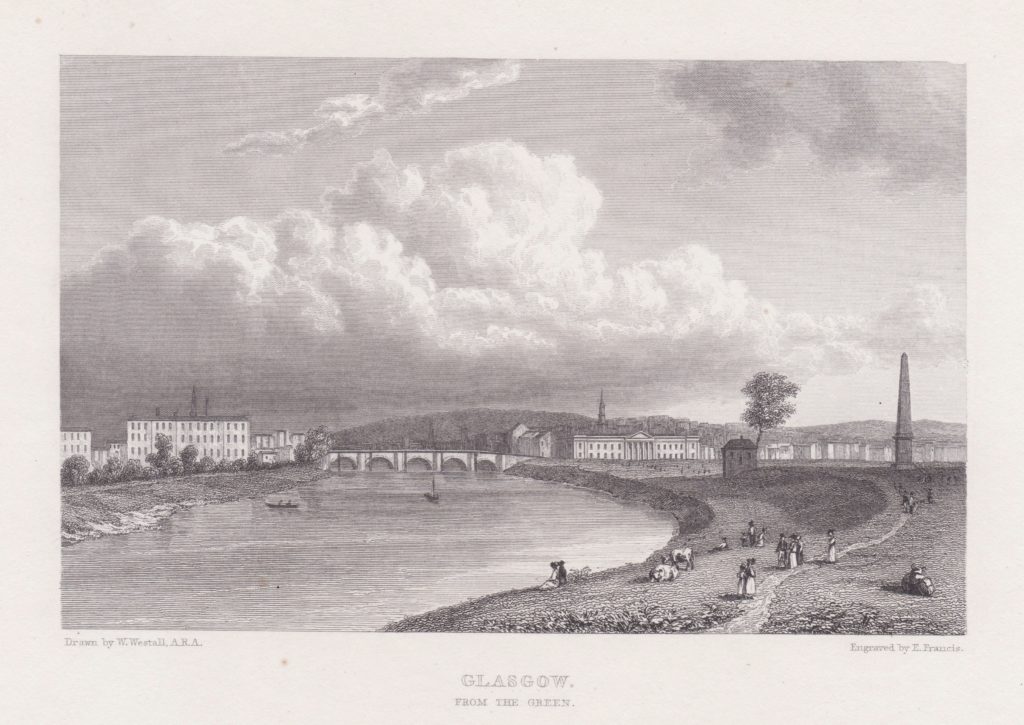Before there were photographs, it was customary to draw or paint locations of interest. One of the ways in which these illustrations could be more widely disseminated was by engraving and printing, and Glasgow was certainly blessed with such capability in the years before photography made its mark.
Here is a print obtained from a steel engraving by E. Francis, taken from a drawing by W. Westfall. The work is entitled “Glasgow from the Green” and is dated 1828.
Rutherglen Bridge is behind and to the left of the viewer in this scene and we are looking at the Great Bridge or Stockwell Bridge in the distance, connecting the Barony of the Gorbals on the left with the City on the right. The order for this bridge to be built was given in the 14th Century by Bishop William Rae, Bishop of Glasgow from 1339 to 1367, and so the bridge came to be known as Bishop Rae’s Bridge or Bishop’s Bridge early on. Today, its current replacement is Victoria Bridge. To the right of the bridge and nearer to us is the Court House with its portico and Doric columns fronting the Saltmarket. Behind it is the steeple of the Merchant’s Hall in the Briggait and by the time this drawing was made, the rest of the Merchant’s Hall had been taken down but the steeple has survived to this day.
The obelisk on the right, designed by David Hamilton, was erected to honor the memory of Vice Admiral Horatio Nelson who commanded the British Fleet in its spectacular victory over the combined French and Spanish Fleets at the Battle of Trafalgar just a few years earlier, in 1805. Glasgow was very quick to honour Nelson. Subscriptions were started in 1805 and the monument was completed by 1807. The part of the Green around the obelisk would become Glasgow’s first golf course. On the far right of the illustration are the fine tenement houses of Monteith Row, also designed by David Hamilton, and the street itself was named after Lord Provost Henry Monteith. Monteith Row would for a time become the most fashionable residential street in Glasgow.
Below, is the original description that accompanied this engraving.
“The Green, a beautiful lawn, stretches along the banks of the Clyde on the eastern side of Glasgow, forming a public promenade, in extent and beauty not to be surpassed except by the Parks of London. This open and verdant space, two miles and a half in circumference, is intersected by gravel walks partially shaded with trees, commanding a fine view of the surrounding scenery. The river Clyde, a noble stream, after pausing at Rutherglen Bridge, makes a bold curve at the bottom of the Green, flowing full, calm, and clear as amber, between the agreeable verdure of its banks. On this spot, near its center, the citizens of Glasgow have erected a monument to the memory of Admiral Lord Nelson, an obelisk, on a graduated basement, one hundred and forty-three feet in height. The north-eastern side of the Green is occupied by Calton, a large and extensive village connected with the city, near which is the public washing-house, where the linen is spread on the fine green turf to bleach.
Immediately fronting the Green is Monteith Row, a line of handsome houses, the east end of which joins the Carlisle Road, conducted by a recent improvement nearly in a straight line from Park Head, where the Edinburgh road meets it. From Monteith Row to the Cross, a new and splendid entrance to the City called London Street, has been lately built, which communicating directly with the Trongate, now forms unquestionably the finest street in Scotland extending from the Green to Anderston on the western side of the City. The Court House with its noble Doric portico, fronts the Green at the bottom of the Salt Market, a street that will never be forgotten as the residence of the warm-hearted Baillie Nicol Jarvie. Near it is St. Andrew’s Square, the spire of its church rising from the centre. The spire of the Merchants’ House in the Briggate, is surrounded by balustrades at different heights. This was built in 1659, and may be considered the finest of its kind in this view of the City, the Cathedral being more than a mile from the river.”

